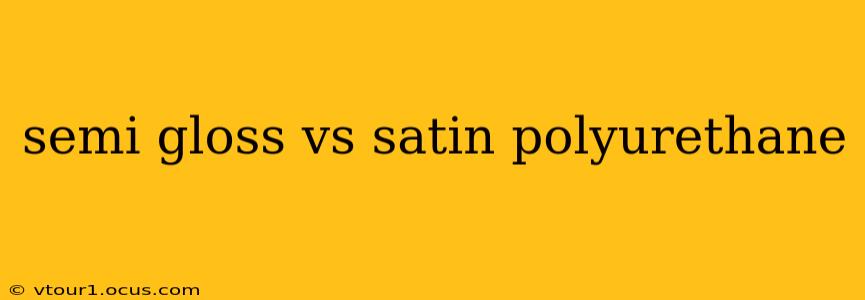Choosing between semi-gloss and satin polyurethane can feel overwhelming. Both offer excellent protection for your wood finishes, but their subtle differences in sheen significantly impact the final look. This guide will help you understand the key distinctions and decide which is best for your project.
What is the Difference Between Semi-Gloss and Satin Polyurethane?
The primary difference lies in the sheen level. Sheen refers to the amount of light reflected from the surface. Satin polyurethane has a soft, subtle sheen, somewhere between a flat/matte finish and a glossy one. Think of it as a low-luster finish. Semi-gloss polyurethane, on the other hand, exhibits a more noticeable shine, reflecting more light. It's noticeably glossier than satin but not as mirror-like as a high-gloss finish.
Semi-Gloss Polyurethane: Pros and Cons
Pros:
- Durability: Semi-gloss offers excellent durability and scratch resistance, making it suitable for high-traffic areas like floors or furniture that receives frequent use.
- Cleanability: The slightly glossier surface is easier to clean than satin; dirt and grime are less likely to adhere.
- Highlights Wood Grain: While not as dramatic as high-gloss, semi-gloss still enhances the wood grain and color, providing a richer look.
Cons:
- Shows Imperfections: Because of its higher sheen, semi-gloss can accentuate minor imperfections in the wood or application. Careful preparation is essential for a flawless finish.
- Less Forgiving: Application requires more precision; uneven coats are more visible than with satin.
Satin Polyurethane: Pros and Cons
Pros:
- Hides Imperfections: The lower sheen of satin polyurethane helps mask minor imperfections in the wood or application, making it a more forgiving option for beginners.
- Warm, Classic Look: Satin provides a warm, elegant feel that complements various design styles.
- Versatile: Suitable for a wider range of projects, from furniture to trim work.
Cons:
- Less Durable: Generally less durable and scratch-resistant than semi-gloss, making it less ideal for high-traffic areas.
- More Difficult to Clean: Dirt and grime can adhere more readily to the slightly matte surface.
Which Sheen is Right for My Project?
The best choice depends on your project's specific needs and your aesthetic preferences:
- High-traffic areas (floors, kitchen cabinets): Semi-gloss offers superior durability and cleanability.
- Furniture (tables, chairs): Either satin or semi-gloss works well; consider your personal preference for sheen and the level of protection needed.
- Trim work (baseboards, crown molding): Satin is often preferred for its less-pronounced sheen and ability to blend seamlessly into the wall.
- Bedrooms or less-used areas: Satin is a good option; its warmer look enhances the overall ambiance.
What about Water-Based vs. Oil-Based Polyurethane?
This is a separate consideration. Both semi-gloss and satin are available in both water-based and oil-based formulations. Water-based polyurethanes are generally easier to clean up, have lower VOCs (volatile organic compounds), and dry faster. Oil-based polyurethanes are known for their durability but require mineral spirits for cleanup and have a stronger odor. The choice between water-based and oil-based depends on your preferences and project requirements.
How to Apply Polyurethane for the Best Results
Regardless of the sheen you choose, proper application is key to achieving a beautiful, long-lasting finish. Always follow the manufacturer's instructions carefully. This includes proper surface preparation (sanding, cleaning), applying thin, even coats, and allowing adequate drying time between coats.
Frequently Asked Questions (FAQ)
Can I apply semi-gloss over satin polyurethane?
Yes, you generally can, but ensure the satin coat is completely dry and cured before applying semi-gloss. However, the reverse (applying satin over semi-gloss) is more challenging and may not produce a satisfactory result.
Which is better for protecting wood floors?
Semi-gloss polyurethane offers better protection and durability for wood floors due to its increased resistance to scratches and wear.
Does satin polyurethane yellow over time?
Both satin and semi-gloss polyurethane can yellow slightly over time, especially oil-based varieties. Water-based options are generally less prone to yellowing.
Can I use polyurethane on painted surfaces?
Polyurethane is primarily designed for wood, but certain formulations can work on other surfaces such as properly prepared painted surfaces. Always check the manufacturer's recommendations before application.
By understanding the subtle differences between semi-gloss and satin polyurethane and considering the factors outlined above, you can confidently choose the right sheen to protect and beautify your woodworking projects.
